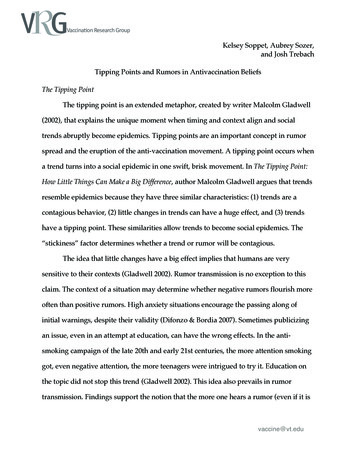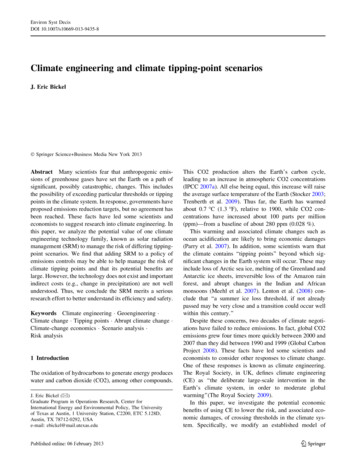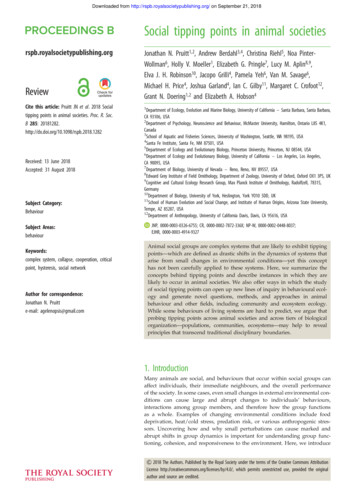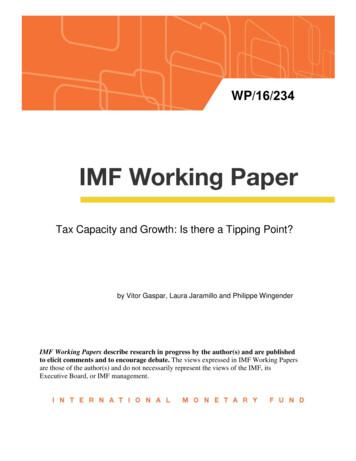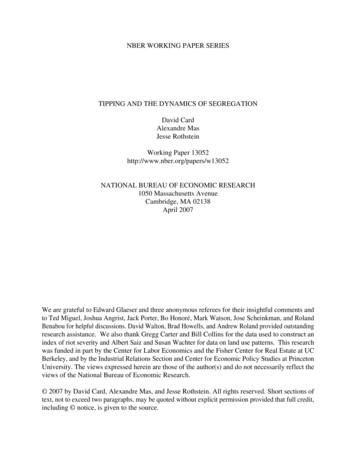
Transcription
NBER WORKING PAPER SERIESTIPPING AND THE DYNAMICS OF SEGREGATIONDavid CardAlexandre MasJesse RothsteinWorking Paper 13052http://www.nber.org/papers/w13052NATIONAL BUREAU OF ECONOMIC RESEARCH1050 Massachusetts AvenueCambridge, MA 02138April 2007We are grateful to Edward Glaeser and three anonymous referees for their insightful comments andto Ted Miguel, Joshua Angrist, Jack Porter, Bo Honoré, Mark Watson, Jose Scheinkman, and RolandBenabou for helpful discussions. David Walton, Brad Howells, and Andrew Roland provided outstandingresearch assistance. We also thank Gregg Carter and Bill Collins for the data used to construct anindex of riot severity and Albert Saiz and Susan Wachter for data on land use patterns. This researchwas funded in part by the Center for Labor Economics and the Fisher Center for Real Estate at UCBerkeley, and by the Industrial Relations Section and Center for Economic Policy Studies at PrincetonUniversity. The views expressed herein are those of the author(s) and do not necessarily reflect theviews of the National Bureau of Economic Research. 2007 by David Card, Alexandre Mas, and Jesse Rothstein. All rights reserved. Short sections oftext, not to exceed two paragraphs, may be quoted without explicit permission provided that full credit,including notice, is given to the source.
Tipping and the Dynamics of SegregationDavid Card, Alexandre Mas, and Jesse RothsteinNBER Working Paper No. 13052April 2007JEL No. J15,R21,R31ABSTRACTIn a classic paper, Schelling (1971) showed that extreme segregation can arise from social interactionsin white preferences: once the minority share in a neighborhood exceeds a critical "tipping point,"all the whites leave. We use regression discontinuity methods and Census tract data from 1970 through2000 to test for discontinuities in the dynamics of neighborhood racial composition. White populationflows exhibit tipping-like behavior in most cities, with a distribution of tipping points ranging from5% to 20% minority share. The estimated discontinuities are robust to controls for a wide varietyof neighborhood characteristics, and are as strong in the suburbs as in tracts close to high-minorityneighborhoods, ruling out the main alternative explanations for apparent tipping behavior. In contrastto white population flows, there is no systematic evidence that rents or housing prices exhibit non-linearitiesaround the tipping point. Finally, we relate the location of the estimated tipping points in differentcities to measures of the racial attitudes of whites, and find that cities with more tolerant whites havehigher tipping points.David CardDepartment of Economics549 Evans Hall, #3880UC BerkeleyBerkeley, CA 94720-3880and NBERcard@econ.berkeley.eduAlexandre MasIndustrial relations SectionPrinceton UniversityFirestone LibraryPrinceton NJ 08544and NBERamas@haas.berkeley.eduJesse RothsteinIndustrial RelationsFirestone LibraryPrinceton UniversityPrinceton, NJ 08544and NBERjrothst@princeton.edu
Social interaction models have been used to explain segregation (Schelling, 1971, 1978;Becker and Murphy, 2000), collective action (Granovetter, 1978), persistent unemployment(Cooper and John, 1988), and crime (Glaeser, Sacerdote and Scheinkman, 1996). The keyfeature of these models is that preferences depend on other agents’ choices, potentially leading tomultiple equilibria and tipping (Brock and Durlauf, 2001b; Glaeser and Scheinkman, 2003).Researchers have attempted to identify preference spillovers by estimating the effect of peercharacteristics on individual decisions (e.g. Case and Katz, 1991; Evans, Oates and Schwab,1992; Kling, Ludwig and Katz, 2005) 1; and by testing for excess dispersion in choices acrosssocial groups (Glaeser, Sacerdote, and Scheinkman, 1996; Graham 2005). To date, however,there is no direct evidence of the tipping behavior predicted by many social interaction models.In this paper we use regression discontinuity methods (Angrist and Lavy, 1999; Hahn,Todd and van de Klaauw, 2001) to test for race-based tipping in neighborhoods. To illustrateour approach, Figure 1 plots mean percentage changes in the white population of ChicagoCensus tracts from 1970 to 1980 against the minority share in 1970. 2 The figure also showspredictions from a local linear regression model, estimated with a break at a 5% minority share –the level identified by two alternative procedures as the most likely potential tipping point. Thegraph shows clear evidence of tipping, with white population gains to the left of the tipping pointand substantial outflows just to the right. We find similar (though less extreme) patterns for abroad sample of U.S. cities in each of the past three decades.We begin the paper by outlining a simple model of a local housing market in whichwhites’ willingness to pay for homes depends on the neighborhood minority share. Under1See Manski (1993) for a discussion of the difficulties in testing for interaction effects, and Glaeser and Scheinkman(2003) for a review of many existing studies.2We express the change in white population as a fraction of the total tract population in 1970. Minorities are definedas nonwhites and white Hispanics.
certain assumptions, shifts in the relative demand of whites and minorities will lead to smoothchanges in the minority share of the neighborhood as long as the minority share remains below acritical threshold. Beyond this tipping point all the white households will leave. The location ofthe tipping point is determined in part by the strength of white preferences for minority contact,and is higher when whites are more tolerant of minority neighbors.We then set out to test for tipping behavior using decadal changes in neighborhoodracial/ethnic composition. A major obstacle is that the location of the tipping point is unknown.We use two approaches to identify city-specific potential tipping points. First, drawing from theliterature on structural breaks, we select the point that yields the best fitting model for tract-levelwhite population changes. Second, building on the pattern in Figure 1, we fit a flexible modelfor tract-level changes in white population shares in each city, and find the minority share with apredicted change equal to the city-wide average change. The methods yield very similar tippingpoints for most cities. The estimated tipping points for a given city are also highly correlatedacross the three decades in our sample.As suggested by the pattern in Figure 1, we find large, significant discontinuities in thewhite population growth rate at the identified tipping points. These are robust to the inclusion offlexible controls for other neighborhood characteristics, including poverty, unemployment, andhousing attributes. Similar tipping patterns are present in larger and smaller cities in all regionsof the country, and in both suburban and central city neighborhoods.Neither rents nor housing prices exhibit sharp discontinuities at the tipping point. 3Nevertheless, tipping has an important effect on the quantity of new housing units, particularly in3In an early study, Laurenti (1960) pointed out that there is little theoretical or empirical support for the widespreadbelief that home values necessarily fall when neighborhoods undergo racial transition.-2-
tracts with remaining open land where new construction is still possible. The rates of populationgrowth and new construction in these tracts falls markedly once a tract reaches the tipping point.We conclude that tipping is a general feature of American cities that has persisted intothe 1990s. This contrasts with the conclusions of an earlier study using the same data (Easterly,2005), which looked for but did not find evidence of the discontinuous neighborhood changepredicted by tipping models. Easterly assumed that the tipping point would be the same in allcities. Our analysis indicates that this assumption is too restrictive. Failure to allow fordifferences across cities in the location of the tipping point smooths out the discontinuities weidentify, masking important tipping effects.We conclude by examining the determinants of the location of the tipping point indifferent cities. Consistent with earlier work by Cutler, Glaeser and Vigdor (1999) onpreferences and segregation, we find that tipping points are higher in cities with more tolerantwhites, underscoring the role of white preferences in tipping and the dynamics of segregation.Tipping points are also related with racial composition, racial income differences, density, crimerates, and measures of past racial tension, all in the expected directions. They rose slightly overthe twenty years that we study, but this is more than explained by demographic changes.II. Theoretical Frameworka. A Model of TippingWe present a simple partial equilibrium model of neighborhood composition that treatslocal housing demand functions as primitive. 4 Consider a neighborhood with a homogenous4The literature contains many models of neighborhood choice that yield tipping behavior, including Schelling (1971,-3-
housing stock of measure one and two groups of potential buyers: whites (w) and minorities (m).Let bg(ng, m) (g {w, m}) denote the inverse demand (or bid-rent) functions of the two groupsfor homes in the neighborhood when it has minority share m, so that there are ng families fromgroup g who are willing to pay at least bg(ng, m) to live there. By construction, the derivatives bw/ nw and bm/ nm are (weakly) negative. The derivatives bw/ m and bw/ m representsocial interaction effects on the bid-rent functions. We assume that for minority shares beyondsome threshold (say m 10%), bw(nw, m)/ m 0. 5At an integrated equilibrium with minority share m (0, 1), the mth highest minoritybidder has the same willingness to pay as the (1-m)th highest white bidder. That is,(1)bm(m, m) bw(1 m, m). 6The derivative of the white bid function bw(1 m, m) with respect to the neighborhood minorityshare is bw/ nw bw/ m. The first term in this expression is positive. If the socialinteraction effect bw/ m is small at m 0 but becomes more negative as m rises, bw(1 m, m) willhave the shape illustrated in Figure 2 – positively sloped at m 0, but eventually downwardsloping. We assume for illustrative purposes that bm(m,m) is downward-sloping and linear. 7In the neighborhood illustrated in Figure 2, there are three equilibria, one all-minorityand two mixed. Point A is a locally stable mixed equilibrium. Just to the right of this point, themarginal white family has a higher willingness to pay than the marginal minority family, and1978), Miyao (1979), and Bond and Coulson (1989). Ours is derived from Becker and Murphy (2000).5Survey evidence suggests that whites prefer a neighborhood with minority share around 10%, and strongly avoidneighborhoods where m 25%. See e.g., Clark (1991) and Farley et al. (1993). Note, however, that unless all whiteshave similar preferences, the market-level demand function need not reflect any single person’s preferences.6Depending on the shapes of the inverse demand functions, this equation may have multiple solutions. There mayalso be corner solutions, all-white when bw(1, 0) bm(1, 0) and all-minority when bw(0, 1) bm(1, 1).7The derivative of the minority bid function bm(m, m) with respect to m is bm/ nw bm/ m. This could bepositive for low m if minorities strongly dislike all-white neighborhoods.-4-
transactions will occur to return the system to A. (A parallel argument applies just to the left ofA). The other mixed equilibrium, B, is unstable: a positive shock to the minority share herewould reduce the marginal white family’s bid by more than that of the marginal minority family,and the neighborhood would trend toward the all-minority equilibrium, C. 8Now consider an all-white neighborhood that experiences rising relative demand byminorities, driven by growth in the population or relative income of minorities in a city. 9 Figure3 shows a series of equilibria for the neighborhood, assuming the demand functions have theshapes illustrated in Figure 2. At low levels of minority demand, m 0 is a stable equilibrium.As bm shifts upward, prices begin to rise and a few minority families displace whites with thelowest willingness to pay. The neighborhood will then be in a stable mixed equilibrium. Furtherincreases in the relative demand of minorities will cause the minority share at the stableequilibrium to rise gradually until bm is just tangent to bw.The minority share at the tangency, m*, is a “tipping point”: once m reaches this level,any further increase in minority demand causes the integrated equilibria to disappear, leavingonly the 100% minority equilibrium. 10 The neighborhood’s minority share will then movetoward m 1. Once this process begins, even a downward shift in the minority demand functionthat restores the integrated equilibria will typically not reverse the tipping process, as m willcontinue converging toward m 1 so long as it lies to the right of the unstable equilibrium.8A standard result is that the number of equilibria, e, must be odd, and that (e-1)/2 of these must be unstable.Most U.S. metropolitan areas have seen rising minority shares in recent decades. An alternative is to assume thathouses become relatively less attractive to white buyers as they age, leading to a relative decline in the white bidfunction over time. This is similar to the filtering model proposed by Bond and Coulson (1989).10An unstable equilibrium (e.g., point B in Figure 2) is often characterized as a tipping point. Our definition of atipping point as a so-called “bifurcation” has several advantages over this. Most importantly, it provides a simpleexplanation for the presence of neighborhoods just to the left of the tipping point. Tipping occurs in only onedirection from m*, whereas an unstable equilibrium is unstable in both directions.9-5-
The location of the tipping point m* depends on the strength of white distaste forminority neighbors (i.e., on bw/ m). If, for example, white demand for a neighborhood falls offsharply once the minority share exceeds 5%, the tipping point will not be much above this level.More tolerant whites will lead to a higher tipping point. 11In this model, the rental price of housing evolves smoothly through the tipping point,despite the discontinuity in white outflows. Rents at the long-run m 1 equilibrium can be higheror lower than at the tipping point, depending on the shape of the minority bid-rent function (andon shifts in minority demand once tipping is underway). As house prices depend on expectedfuture rents, price changes as m passes though m* depend on expectations about the futureevolution of the neighborhood. A useful extension of the model – particularly given the resultson neighborhood population growth presented below – would incorporate housing supply, whichmay also depend on expected future rents. Careful modeling of expectations is complex andbeyond the scope of this paper. 12 We merely note that prices and rates of new construction may,but need not, change discontinuously when a neighborhood tips.b. Empirical ImplicationsIn Figure 3 we assumed steady increases in relative minority demand. On average this islikely to be true, since minority populations have risen in most U.S. cities over the past 50 years.Even so, there are also likely to be neighborhood-specific shifts in relative demand (i.e. inbm(m,m) – bw(1 m, m)). Under standard assumptions on bw and bm, small shifts in relativedemand will produce small changes in the location of the integrated equilibrium, so long as it1112For fixed white demand, the tipping point will be lower the stronger are minority tastes for higher m.Merton (1948) provides an early discussion of the role of “self-fulfilling prophecies” in neighborhood change.-6-
remains below m*, and the neighborhood will move smoothly toward the new equilibrium. 13 Fora neighborhood with an initial minority share mt 1 somewhat less than m*, the expected changein the minority share is therefore a smooth function of mt 1. Formally, if mt 1 [0, m* r), wherer represents the maximum (scaled) relative demand shock between t 1 and t, E[Δmt mt 1] g(mt 1) for some continuous function g. By contrast, the expected change for tracts that havebegun tipping is positive: E[Δmt mt 1] h(mt 1) 0 for mt 1 m*. The intermediate range isa grey area—tracts with initial minority shares in [m* r, m*] will tip if they experiencesufficiently large shocks, but not otherwise. Assuming this range is small:(2)E[Δmt mt 1] 1(mt 1 m*)g(mt 1) 1(mt 1 m*) h(mt 1).If limε 0 h(m* ε) g(m* ε) 0, the right hand side of this expression is discontinuous at m*.Given the nature of g and h, we expect the jump to be large. We therefore test for tipping bytesting for a discontinuity in E[Δmt mt 1] at candidate values of m*. Note that the derivation of(2) suggests the function E[Δmt mt 1] may not be strictly discontinuous at m* but only steeplysloped in the [m*–r, m*] range. 14 We interpret such a pattern as evidence of tipping.c. Empirical SpecificationOur empirical analysis uses Census tracts as neighborhoods, and measures changes intheir composition over the 10 year intervals between Censuses. While the model presentedabove assumes a fixed supply of housing in each neighborhood, most tracts in our sampleexperience significant growth in their housing stocks and populations. To allow for shifts in thepopulation of a tract, we model changes in the numbers of white and minority residents in the13The required condition is that [ dbw(1-m, m)/ dm dbm(m, m)/ dm ] 1 is continuous. This will hold (everywherebelow the tipping point) if the two bid functions are continuous and concave.14Any heterogeneity in the location of the tipping point across a city’s neighborhoods or imperfect alignmentbetween actual neighborhood boundaries and those that we use for measurement of m will lead us to smooth awaytrue discontinuities and will produce a similar pattern of a steep slope in a range around m*.-7-
tract, each expressed as a fraction of the base-period population. Specifically, let Wic,t, Mic,t, andPic,t ( Wic,t Mic,t) represent the numbers of whites, minorities, and total residents of Census tracti in city c in year t ( 1980, 1990, 2000). Our main dependent variable is the ten-year change inthe neighborhood’s white population, taken as a share of the initial population, Dwic,t (Wic,t Wic,t 10) / Pic,t 10. We also examine analogous measures for minorities and the total population,Dmic,t and Dpic,t Dwic,t Dmic,t, respectively. Our key explanatory variable is the base-yearminority share in the tract, mic,t 10 Mic,t 10/Pic,t 10.Equation (2) asserts that E[Dwic,t mic,t 10 ] is a smooth function of mit 10, except perhapsat the tipping point m*. We assume that a tipping point (if it exists) is specific to a given city anddecade, and we define δic,t 10 mic,t 10 – m*c,t 10. Our basic empirical specification is:(3)Dwic,,t p(δic,t 10) d 1[δic,t 10 0] τc Xic,t 10β εic,t,where τc represents a city fixed effect, Xic,t 10 is a vector of tract-level control variables, andp(δic,t 10) is a smooth control function, which we model as a 4th-order polynomial. 15 We estimate(3) separately by decade. In some specifications we also allow the discontinuity d and theparameters of the p( ) function to vary across cities.d. Identification of the Tipping PointA key problem in estimating a model like (3) is that the discontinuity point m*c,t 10 mustbe estimated from the data. We assume for the moment that a tipping point exists (i.e. d 0),and focus on estimating its location. We discuss the possibility that d 0 in the next subsection.We use two methods to obtain candidate values of m*c,t 10. The first is a search techniquesimilar to that used to identify structural breaks in time series data. Ignoring covariates and15While p() should in principle be allowed to have discontinuous derivatives at 0, to allow (for example) h’(m*) g’(m*), our explorations with such models indicate that this flexibility is unnecessary.-8-
approximating p() by a constant function in the [0, M] range, equation (3) becomes:(4)Dwic,t ac dc 1[mic,t-10 m*c,t-10] εic,t ,for 0 mic,t 10 M,We set M 60% and select the value of m*c,t-10 in the [0, 50%] interval that maximizes the R2 of(4), separately for each city and decade. Hansen (2000) shows that if (4) is correctly specifiedthis procedure yields a consistent estimate of the true change point m*c,t-10. 16This procedure works well for larger cities but performs poorly in a few smaller cities,sometimes choosing a value for m* that reflects obvious outliers. Our second, preferredapproach builds on the consistent shape of smoothed approximations to E[Dwic,t c, mic,t 10 ] formany different cities. 17 Typically, this function is positive but relatively flat for low values ofmt 10, then declines sharply. Beyond the range of transition, E[Dwic,t c, mic,t 10 ] is againrelatively flat until, at a minority share of about 60%, it begins to trend upward, approaching 0 asmic,t 10 1. 18 Interpreting the sharp decline as tipping behavior, this pattern implies that tractswith minority shares below the tipping point experience faster-than-average growth in whitepopulation, whereas those above it experience a relative decline. If there is a tipping point at m*,then:(5)E[Dwic,t c, mic,t 10 m* – ε] E[Dwic,t c] E[Dwic,t c, mc,t 10 m* ε] for ε 0.The city-specific tipping point is a “fixed point”: the minority share at which the whitepopulation of the tract grows at the average rate for the city. To identify this fixed point, wesmooth the data to obtain a continuous approximation, R(mt 10), to E[Dwic,t c, mic,t 10] – E[Dwic,t16Loader (1996) shows that the location of change points can be estimated non-parametrically using local linearregression methods. These methods would be appropriate for the largest cities in our sample.17Many cities experience rising minority shares over our sample period. To abstract from city-wide trends, we focuson E[Dwic,t c, mic,t 10 ] – E[Dwic,t c], which equals zero when tracts are evolving in step with the city as a whole.18Dwic,t can never be lower than mic,t 10 – 100, corresponding to total loss of the t 10 white population by year t.Many neighborhoods with m ic,t 10 above 60% approach this limit.-9-
c], then select the root of this function. 19 We refer to this as our “fixed-point” procedure. 20d. Hypothesis TestingIf our functional form assumptions are correct, both procedures will yield consistentestimates of the location of any true discontinuity. A standard result in the structural breakliterature (see, e.g., Bai, 1997) is that sampling error in the location of a change point (m*) can beignored in estimation of the magnitude of the break (d). We rely on this result, and do not adjustour standard errors for the estimation of m*. 21Under the null hypothesis that there is no discontinuity, however, the estimate of d has anon-standard distribution. The problem is essentially one of specification search bias (Leamer,1978): When the same data are used to identify the location of structural break and to estimateits magnitude, conventional test statistics will reject the null hypothesis d 0 too often. The usualsolution (Hansen, 2000; Andrews, 1993) is to simulate the distribution of dˆ under the null, thencompare the estimate to this distribution. We use a different approach that permits conventionaltests. We use a randomly selected subset of our sample for our search procedures and use theremaining subsample for all further analyses. Because the two subsamples are independent,19We use a two-step procedure to improve precision. We first fit Dwic,t - E[Dwic,t c] to a quartic polynomial inmic,t 10, using only tracts with mic,t 10 60%, to obtain R(mt 10). After identifying a root of this polynomial, m’, wediscard all tracts with abs(mic,t-10 – m’) 10 and fit a second quartic polynomial to the remaining tracts. Ourcandidate point, m*, is a root of this second polynomial. We consider only minority shares below 50% as candidatepoints. When there are multiple roots in this range, we select the one at which the slope of R(m) is smallest (mostnegative). In a few cities, R(m) has no roots below 50%. These cities are excluded from the fixed-point analysis.The Data Appendix discusses the details of the algorithm in greater detail.20We also explored a third procedure, selecting values for which a smoothed approximation to E[Dw c, m] is mostnegatively sloped. Though this procedure agreed with the other two in many cities, in others it was poorly behaved.21Appendix C presents bootstrap standard errors for our primary specification. Our most conservative approach(which re-samples both cities and tracts within cities) yields slightly larger standard errors than those reported inTable 3, but the differences are not large enough to qualitatively affect the interpretation of the estimates. AppendixB presents a falsification exercise, in which we apply our methods to data generated by a continuous process. Thisindicates that the size of our tests is reasonable, around 6%.-10-
estimates of dˆ from the second sample have a standard distribution, even under the null. 22e. Testing other implications of the tipping modelThe model in Section II predicts that rents will evolve smoothly through any tippingpoint, though it has no clear prediction for housing prices. To explore tipping effects on rentsand prices, we estimate models similar to (3), but with the change in average rents or in theaverage value of owner-occupied homes as the dependent variable. We also explore theprediction that the tipping point will be higher in cities where whites are more tolerant ofminority neighbors by relating the estimated tipping point for a city to survey-based measures ofthe racial tolerance of the city’s white population, controlling for many other city characteristics.III. Data and Potential Tipping Pointsa. Tract Level DataOur primary data source is the Neighborhood Change Database (NCDB), a panel ofcensus tracts matched from 1970 to 2000. Tracts are areas of about 4,000 people, drawn torepresent demographically homogenous neighborhoods. The NCDB provides population countsand other tabulations from each Census year for each year-2000 census tract, mapping the earlierdata onto the current boundaries. 23 We do not exploit the full panel structure of the NCDB, butfocus only on changes over three ten-year inter-censal windows: 1970 to 1980, 1980 to 1990,and 1990 to 2000. In 1970, tract-level data were collected only for the central areas of many22Angrist, Imbens, and Krueger (1999) propose a split sample approach for IV estimation with weak instruments.Estimates based on the full sample show somewhat larger, more precisely estimated discontinuities than our splitsample estimates.23Ideally, we would hold tracts fixed at their initial boundaries, as later boundaries may be endogenous. We wereable to construct our own panel of tracts for our 1990-2000 analyses using 1990 boundaries. Results on this panelwere very similar to those from the NCDB data, and were unchanged by dropping tracts with boundary changes.-11-
MSAs, so our analysis for the 1970-80 period is based largely on central city neighborhoods.We are able to include more suburban areas in analyses of the 1980s and 1990s. We excludefrom each ten-year sample tracts that were largely undeveloped (had very few residents) in thebase year.Our “cities” are metropolitan statistical areas (MSAs) and primary metropolitanstatistical areas (PMSAs), as defined in 1999. We exclude cities with fewer than 100 sampletracts, effectively limiting our analysis to larger metropolitan areas. The Data Appendixdescribes our sample selection procedures in detail.Table 1 presents summary statistics for the tract-level data. The NCDB has 1970 data onabout 46,000 tracts, increasing to 65,000 in 1990. After dropping undeveloped tracts, those thatcannot be matched over time, and all tracts from smaller cities, our sample includes roughly40,000 tracts from 114 metropolitan areas. The white populations of the cities in our samplehave grown over time, but because minority (i.e., non-white and Hispanic) populations havegrown faster, the average minority share has risen steadily, from 16% in 1970 to 29% in 1990.The remainder of Table 1 compares four subgroups of tracts, defined by the fraction ofminority residents in the base year. In 1970, nearly one-half of tracts in our sample hadminority shares below 5%. By 1990, only a quarter had such a low minority share. This declinewas offset by growth in the 20-40% minority group (which rose from 10% to 35% of all tracts)and the 40% or higher group (which rose from 13% to 27%). The growth rate of the whitepopulation is strikingly different across subgroups, averaging 19% in the two lower-minorityshare groups and negative or close to zero in the higher-minority-share groups.b. Estimated Tipping Points-12-
Figure 4 presents data similar to that in Figure 1 for a selection of cities in our sample.The vertical lines in each panel represent the estimated tipping points – solid for the pointselected by the “fixed point” method and dashed for the point selected by the “structural break”method. (Where only one line is shown, the two coincide.) Both points are identified from arandomly-selected 2/3 subsample of tracts in each city. 24 We also plot two approximations toE[Dwic,t c, mic,t 10 ], computed on the remaining 1/3 subsample of tracts. The dots represent themeans of Dwic,t among all tracts with mic,t 10 in each 2-percentage-point bin. The solid linesrepresent a local linear regression fit to the underlying data, allowing a break at the estimate ofm* from the fixed point method. Finally, the horizontal line in each figure shows the city-wideaverag
the tipping point is determined in part by the strength of white preferences for minority contact, and is higher when whites are more tolerant of minority neighbors. We then set out to test for tipping behavior using decadal changes in neighborhood racial/ethnic composition. A major obstacle is that the location of the tipping point is unknown.

